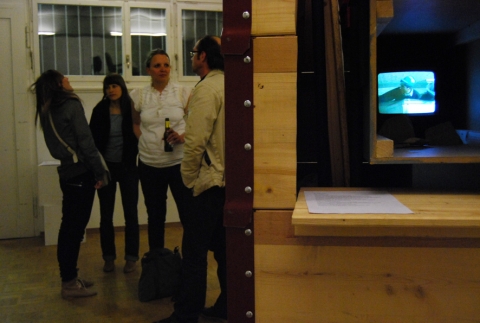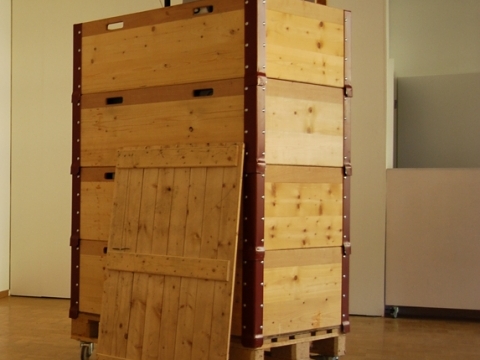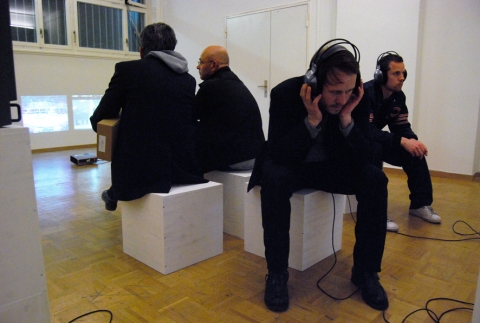curating.org
Shared Projects
Left Over
Initiated by Value: Christoph Lang, Stephan Meylan
24 February–5 June 2009
White Space Zurich
San Keller, !Mediengruppe Bitnik, Thomas Galler, Zeljka Marusic, Stefan Buerger, Kerim Seiler, Margot Zanni
Left over, left out, left in?
What is the value of leftover material from artists’ actions and performances? Can relics retroactively acquire the status of a work? What happens with installations when the exhibition is over?
The exhibition series in White Space throws light on the meaning, value, and function of leftovers, the “surplus” and “rejects” in the art business. Artists articulate their positions with new and recycled works as well as in video interviews. Each evening new works and videos are added. The series is concluded with statements by curators who discuss the notion of leftovers from their perspectives.
For the work San Keller, Ohne Titel (Keller), Videoinstallation, 2009 (San Keller, No title (Basement), video installation, 2009) the artist went into his basement in order to discover, like a traveller, the things that had accumulated there over the years. The material consists of the rests and remainders from his actions and works that had found their way into the basement. San Keller finds and unpacks them before then either packing them up again or bringing them out of the shadows.What takes place in the lower floor is both a verbal and a non-verbal dialogue, a journey through various ideas, works, affiliations, and actions of the past years. The artist evaluates and sorts the objects according to their importance and meaning. In White Space the objects are charged with new presence in their current constellations, and they connect with each other, transforming previously autonomous leftovers into one single leftover – and one single exhibition object.
!Mediengruppe Bitnik is interested in the principles of various systems which it analyses, converts, and subverts. In the work Militärstrasse 105 – Unterwachung (Military Rd 105 – Infravision) Bitnik uses self-made video signal receivers in order to pick up hidden video surveillance signals employed by the city police in public spaces and make them visible. Bitnik thus provides visitors with access to “surveillance from above” – surveillance becomes sousveillance. The signals in the urban space construct an invisible city, a second world that exists alongside the visible manifestation. The records which the two surveillance cameras in Militärstrasse 105 generate continuously are lost in the very moment of their creation. They gain attention and significance only when they record exceptional situations. Otherwise they constitute lost material. In White Space the lost material is made visible and acquires a new official presence.
Alex’ voice speaking from an old loudspeaker translates written texts into spoken language. It is the “text-to-speech” Mac OSX software for language synthesis. The voice character Alex speaks the text S.C.U.M. (Society for Cutting Up Men) Manifesto by Valerie Solana, which is one of the most radically hostile and man-hating feminist texts of the 1960s. The sound installation MANIFESTO, 2009 / 2007. S.C.U.M. Manifesto, Valerie Solanas, 1968 by Thomas Galler leaves the highly emotional text suspended in space and soulless, its words apparently no more than a series of empty phrases – dealing a forceful blow to the ambivalence of feminist tendencies today. The work indicates a shift in public discourse with regards to feminism. The work, which the artist declared as a “leftover”, is particularly interesting in the context of the process that led to his decision not to publish this work. The fact that feminism is no longer socially presentable means that the work has become a “leftover” and a worthy topic of debate in our society.
Zeljka Marusic’s artistic practice is characterised by spacious installations, video projections, and sculptural objects. In her contribution in White Space the artist refers to the finished individual exhibition Ghettoblaster / Sehnsucht nach schöner & gr. Welt, (Ghettoblaster / Nostalgia for a beautiful & w. world) in Kreuzlingen, in which she condensed spatial construction, video projection, objects, and pictures in the form of a three-dimensional collage so as to form a complex and ephemeral installation. Whilst the site-specific and accessible spatial constructions made of roof battens, packaging material, and artificial lawn where dismantled and recycled, videotapes, audio recordings, objects, and pictures remained. In White Space Zeljka Marusic on the one hand stages the dismantled spatial construction using a model and plans, but on the other hand she arranges “leftovers”, objects that were left over from the installation, into new spatial constellations.
The work 1,5 Jahre Nadelfilz im Fotohof (1.5 years of needle felting in the Photography Court) by Stefan Burger consists of a grey carpet which the artist was able to salvage during renovation works in the entrance area of Fotohof Salzburg. From its 1.5 years of use in the Fotohof the needle felt carpet bears significant characteristics of extended photography. Traces of exposure to light as well as minimal wear and tear to the surface caused by recipients in the Fotohof define this carpet as a fundamental example of an extended notion of photography. The artist failed to find an appropriate exhibition venue for this work. Various institutions of photography such as the Fotomuseum Winterthur declined the gift of the work 1,5 Jahre Nadelfilz im Fotohof. In White Space Stefan Burger shows the correspondence between artists and institutions in the context of the needle felt carpet. The leftover from the Fotohof Salzburg, which the artist designates as a quintessential example of an extended notion of photography, has not yet found a place within the institutional framework of a photographic collection. Since its rejection by institutions in a photography context the work 1,5 Jahre Nadelfilz im Fotohof temporarily served as a vertical element of acoustic attenuation in the flute room of Hwa-Za Burger-Cho, the artist’s mother.
The works of Kerim Seiler resemble hybrid ‘thought spaces’, inspired by architectural and sculptural as well as cultural and mental forms. He creates spatial installations that can be experienced through the senses and which are designed for performances in order to probe and extend the boundaries between those parameters. The large works emerge like free projections in relation to the existing space-time structure. The artist likes to speak of “parasitic forms”, which dock on to this multi-dimensional ensemble. His contribution to “Leftover” shows two documentary prints of destroyed sculptures, one in Chur and one in Schlieren. Here ‘leftover’ means something that has become waste. What has been captured are the cut-offs, the remainders that have been reduced to their materiality.
In the video composition Wild Orchids, 2009 by Margot Zanni we see actors working on a scene in a continuous film loop. The unused material from an earlier project by the artist serves as the basis for the present work. In the new montage the artist does away with the audio track and assembles the remainders from the original project into a new work. The fictional focus of the previous work shifts; the new narrative form enables a radically new view of the raw material. A new field of visual and content-related orientation opens up for the viewer, and the actresses’ facial expressions become the main component of the newly emerging work. With her work Wild Orchids Margot Zanni points to the controversial assessment of “leftovers” in artistic production by creating a new and strong work from what were supposedly just scraps.
National and international curators articulate their positions on various questions and aspects of the notion of leftovers in the art business. Here in White Space, their experiences and thoughts relating to scraps and remainders, to previously unimagined potentials, or to things that were never realised in their curatorial activities are presented in condensed, mostly written form and enter into a dialogue with the artistic contributions and video-interviews. The idea is to place curators and artists into a discourse, to reflect their positions and roles, their commonalities and differences in thought and action, and to bring them together in this exhibition. Questions regarding the feasibility of an exhibition in both spatial and financial terms are coupled with ethical and moral views, providing insight into a complex subject matter. The video interview with Joshua Simon deals with the censorship issues that led to the cancellation of the exhibition Aesthetics of Terror. At the same time this temporary “exhibition leftover” opens up an international curatorial dialogue with new potential for exhibitions and reproductions.
Curatorial statements by
Diana Baldon, Akademie Wien; Barnaby Drabble, Zurich and Edinburgh, UK; Oliver Kielmayer, Kunsthalle Winterthur; Annemarie Hürlimann, Büro «Praxis für Ausstellung und Theorie», Berlin; Dorothee Messmer, Kunstmuseum des Kantons Thurgau, Karthause Ittingen; Heike Munder, Migromuseum für Gegenwartskunst, Zurich; Joshua Simon, Tel Aviv-Jaffa, Israel; Astrid Wege, Kunsthaus Köln; Rein Wolfs, Fridericianum, Kassel.
Leftover is an exhibition series by Curating Plattform and value in collaboration with the Institute for Theory (ith). Project members:
value
Christoph Lang, Stephan Meylan.
Curating Plattform
Renata Burckhardt, Martha Cerny, Daniela Geering-Fuentes, Tomas German, Angela Köhler, Jörg Kohnen-May, Sonia May, Valentine Meyer, Zoë Meyer, Andrea Roca, Fredi Schelb, Anca Raluca Sinpalean, Monika Winkler-Steinmetz, Thomas Zacharias.
Supported by
Migros Kulturprozent Zurich and ‘Ernst und Olga Gubler-Hablützel Stiftung’
White Space Office for Curating / Art / Theory, Militärstrasse 76, CH–8004 Zurich, www.whitespace.ch



